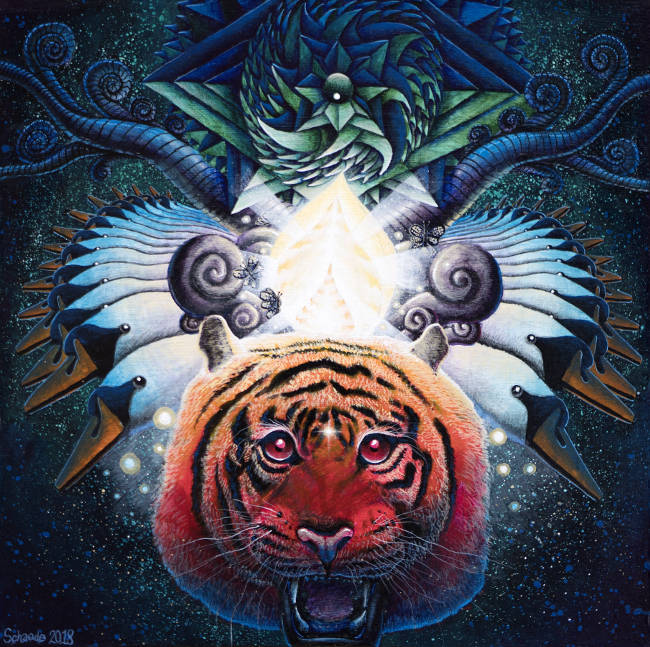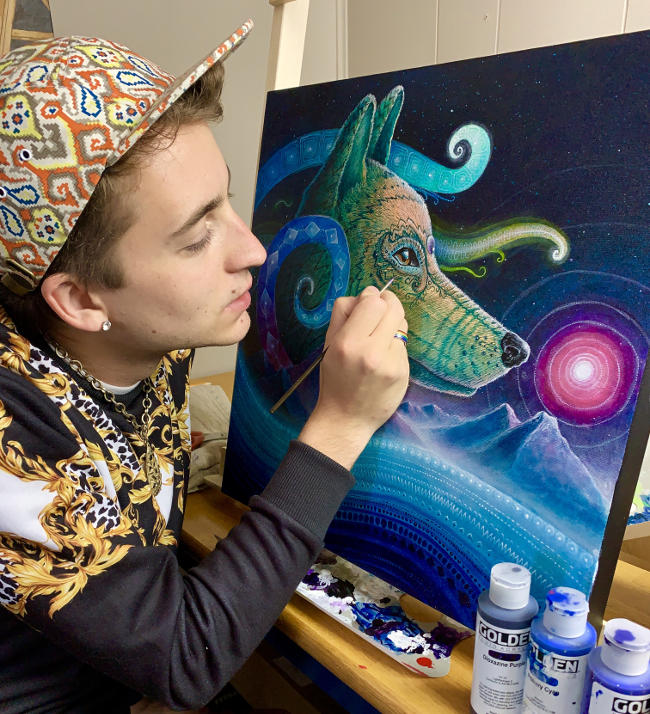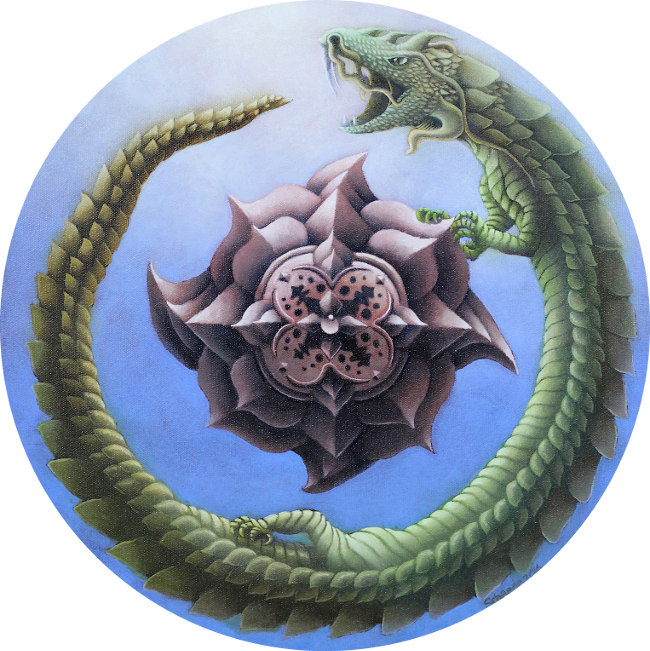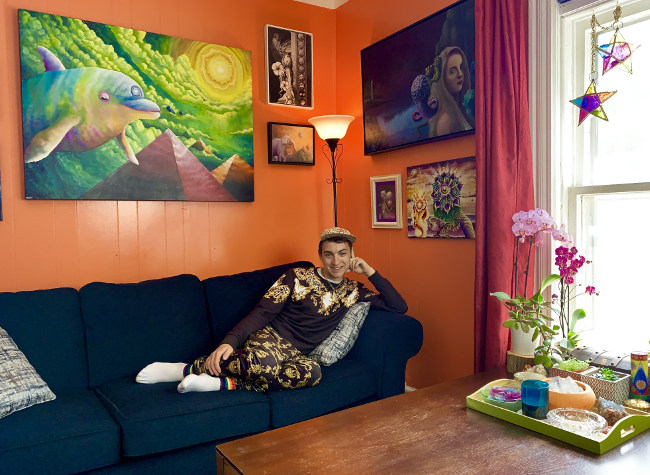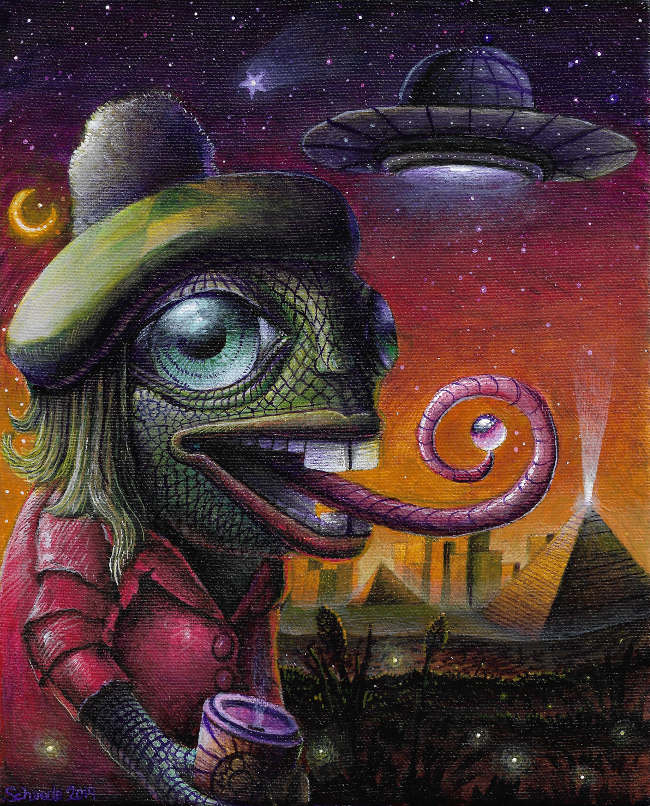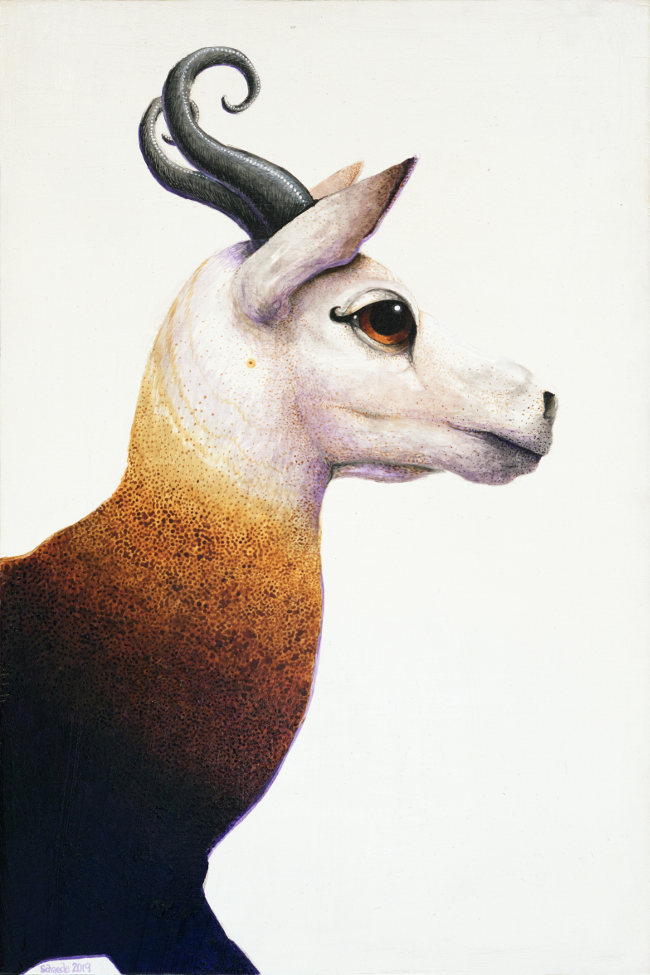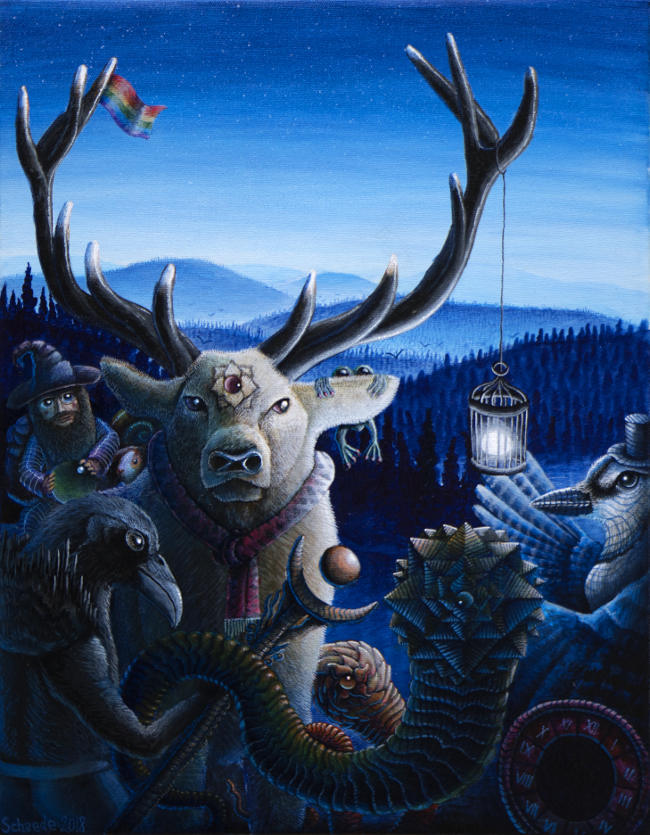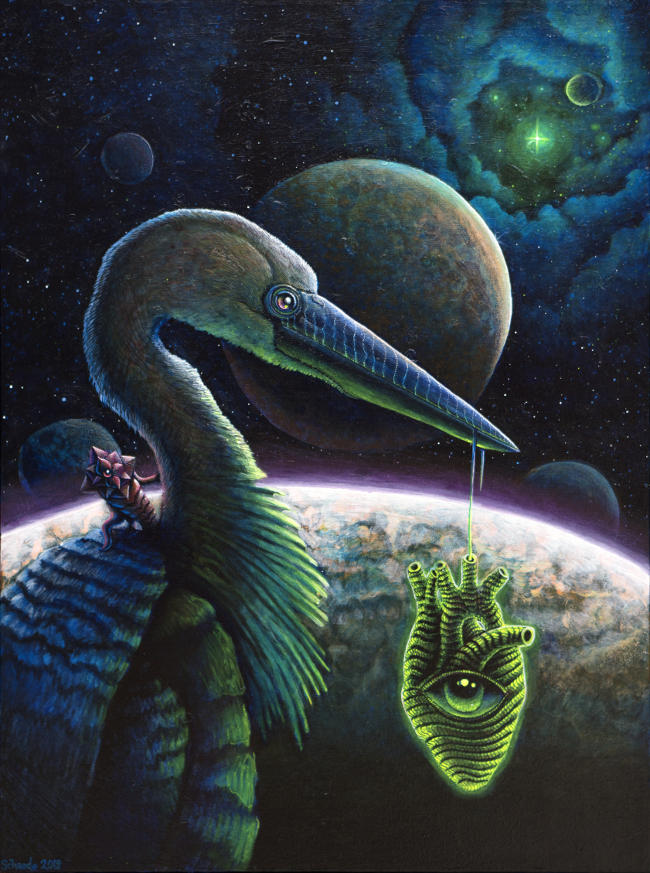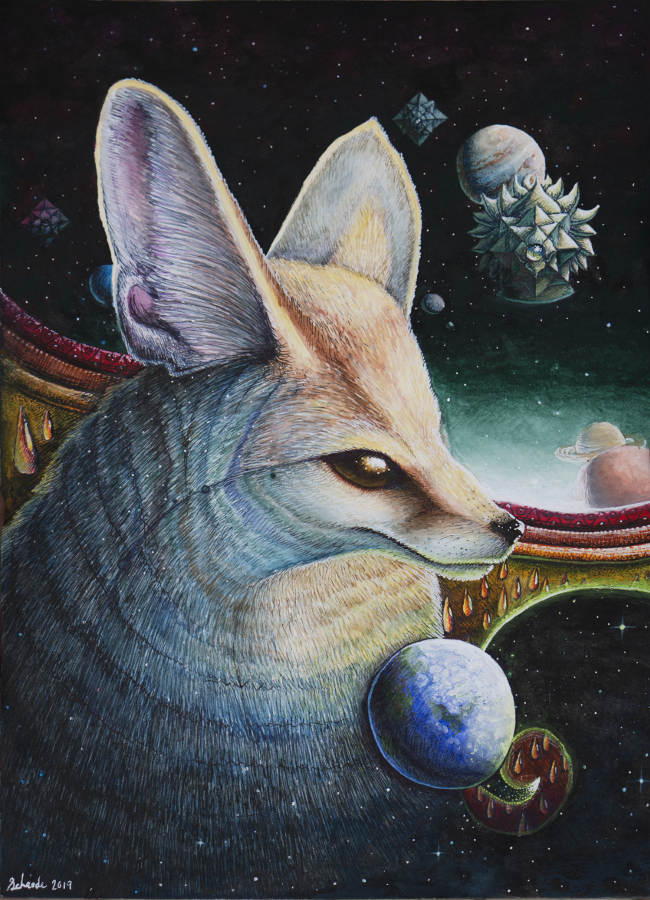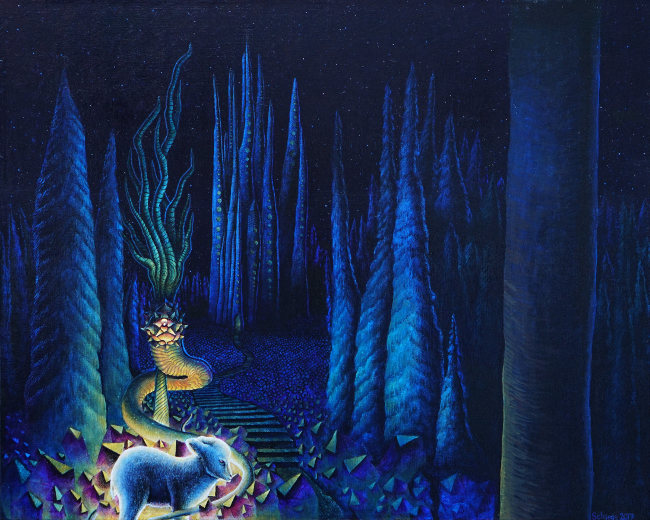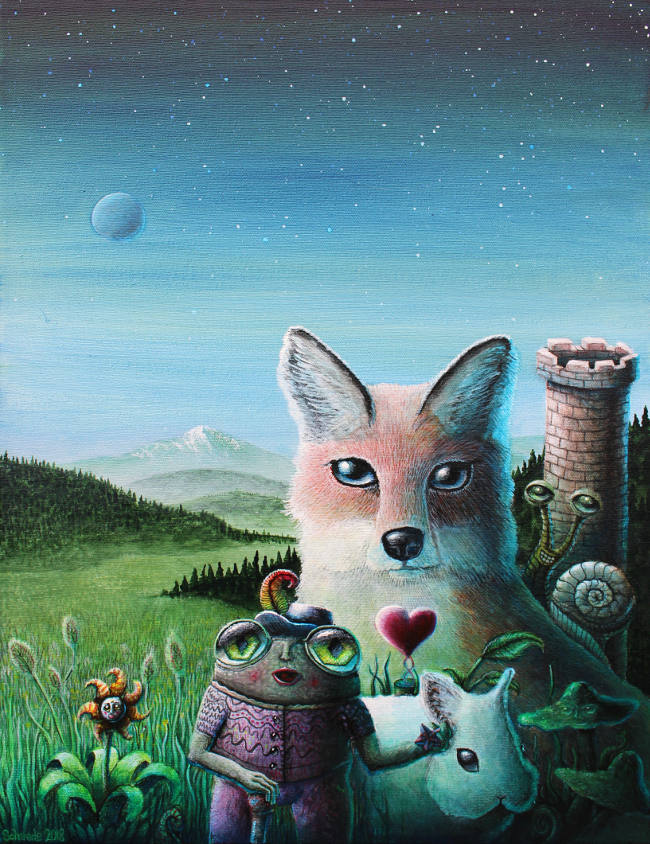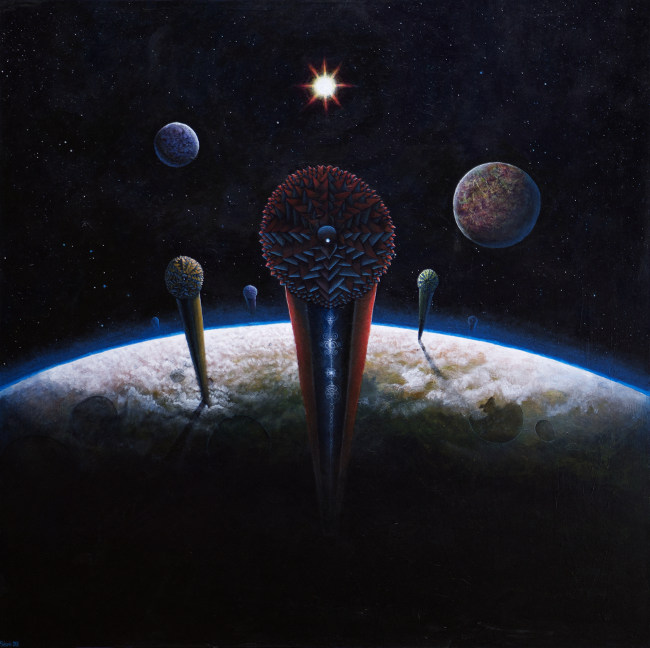Ricky Schaede’s paintings piqued my interest from the very first time I laid eyes on his work, looking at his piece ‘Forgiveness’. Something about it drew me in: his swirling patterns and use of colour played with a beauty found in many artworks in the Visionary Art field. Partnered with an insightful commentary, I found myself connecting to the painting on an even deeper level. What had been going Ricky Schaede’s mind to portray Forgiveness in such a way? What had led him to this style of painting? Exploring more of his pieces, I also discovered a host of charming tales accompanying some of the characters he created. I could almost see Ricky following his characters into new worlds and adventures, bringing them to life on the canvas from places that we can never reach.
At the age of 25, Ricky already has a host of experiences under his belt, which have helped to mould his creative pathway. “I do think the Sacred Fire Ceremonies in Guatemala was the first in a chain of events that led me to painting,” Ricky muses “I am so grateful for that.” His journey so far has led him into vision quests, teaching children, co-founding a youth arts project and providing art which delves into the darker side of his own personality as well as celebrating the good.
So take a journey with me, and discover more about Ricky Schaede in this exclusive interview.
Forgiveness
Ricky Schaede
Ricky Schaede Interview
There are certainly esoteric, even psychedelic elements to your paintings; how do your artworks reflect who you are, personally?
As an artist, I choose live in a fantasy world where magic is real and comes in any form I choose. I take inspiration from a variety of cultures, religions, spiritual beliefs, and also from the psychedelic experience. As a person, however, I am very sceptical with my beliefs and I like to have a clear separation between what is my fantasy and what I accept as reality.
I feel like life is a constant effort to remain childlike at heart, and I create my art to connect to my inner child
Even though I have this skeptical perspective as a person, my every day is suffused with fantasy. I am always imagining creatures, characters, and magical worlds, as well as exploring the fantasy and sci-fi creations of other artists in books, movies, series, and other works of art. My artwork reflects my open mindedness and my absolute love for fantasy and science fiction. It is also usually bright and colourful, and I can be quite a fun, bubbly, outgoing person who loves colour, yet some pieces are darker and more mysterious, which represents my more introverted side which often rules me. I am also a kid’s Art Instructor; I’m always inspired by the works of art my kids create, and I have often created pieces based on inspirations I find working with kids.
I feel like life is a constant effort to remain childlike at heart, and I create my art to connect to my inner child and to be in that space of childlike wonder as much as I can. I like to hold that space as a person and an artist so that I can remind others to be joyful, have fun, and express themselves freely.
Sacred Fire Ceremony
I’m really intrigued by the sacred fire ceremonies, which you participated in when you were 19. How was that a turning point in your private and artistic life?
Okay, this might be a long story but it leads to the point where I decided to pursue visual art, so I think it’s worth it. When I was 19 – only six years ago – I travelled to Guatemala with my brother and his girlfriend for a month. This was my first time leaving my home country ever and I had no idea what to expect, but my brother’s girlfriend had been before and she was our guide. I was terrified but excited. We stayed in a beautiful village on Lake Atitlan in Guatemala. We rented a house from a Mayan family in the barrio for most of our stay, but for seven days of the trip, we travelled with a group of shamans and tourists on a series of Sacred Fire Ceremonies, each ceremony taking place at a different Mayan ruin throughout the country.
Letting Go
We travelled with a group of shamans and tourists on a series of Sacred Fire Ceremonies, each ceremony taking place at a different Mayan ruin throughout the country.
At this time, I was pursuing a career as a novelist and working on my second manuscript. During each fire ceremony we would put our intentions into an object and put that object into the fire. I remember always putting the intention of being a successful novelist into the fire, and of living a life of creativity. One of the things I put in the fire was getting a job at this cool cafe in my town when I got home, called Euphoria. I really didn’t know at the time that I would switch directions into visual art, so none of my intentions were about being a painter. The trip to Guatemala taught me a lot about how people live when they don’t have money and first world amenities; it really taught me how privileged I am and to not take my resources for granted.
I felt like a new person afterwards, with so much more confidence and perspective. When home, I finished my manuscript (‘Annagella’, a fantasy sci-fi epic) and tried to get some friends to read it and make notes, but nobody did. I felt discouraged as a result and found myself in a creative slump, unsure of what to do with myself. Do I start another manuscript that nobody will read? Then, out of the blue, the owner of that cool cafe Euphoria offered me a job – no need for a resume, interview, anything.
Had the sacred fire worked its magic?
Had the sacred fire worked its magic? After working there a few weeks and still being in my ‘creative slump’, I realized I still had paints and a few wood boards to paint on, so I started painting again just to get my creative muscles working, even if it wasn’t writing. I fell in love. I’d painted before, but something about it this time was different. I loved the whimsical animals I found on the canvas before me and I kept painting all that summer. In the fall, my boss offered for me to have my first ever art show at the cafe, and after selling a bunch of work then, I haven’t stopped painting and pursuing a career as a visual artist.
Ricky Schaede
Squigley’s Walk Home
Cassiel
Larger narratives: past & present
You often express these fascinating stories behind your paintings. I know you also used to indulge in creative writing… some of the ‘stories’ accompanying your painting feel like excerpts from a larger narrative – is this the case?
I haven’t deliberately planned a larger narrative, but I feel like each painting I create has become a thread in a story that is being woven subconsciously I know that one day the story will take shape in my mind and I can start writing something that will be illustrated by my work. But it isn’t deliberate. It’s almost like a story is writing itself.
Have you always painted to record a certain story or event or is this a more recent development?
First comes the painting, without any pre-planned narrative, and then comes the writing to accompany the image. Some paintings speak a clear story to me, and others not so much. Some paintings are more about a concept than a story, like my piece Forgiveness, whereas a piece like Winterheart to me tells a clear story, but is also about the concept of seasonal depression and friendship. Then there is a piece like Fen at Heart, which to me is purely storybook. Every painting is different and usually nothing is pre-planned; like to let my inspiration lead me to the finished product.
Would you say your paintings are a visual diary of your life?
In a way they are, yes. To me, works of art are a record of a period in time. Everything that happened to me, the songs I listened to, the feelings I felt and the things I did are all recorded in the strokes and washes of paint on the canvas. Not in such a literal way, but more abstract. I can look at an old work and have deja vu moments to back when the work was being created, evoking old feelings and experiences.
Your father introduced you to painting; was he a painter too?
My father was a hobbyist painter and wood carver. I was always amazed by his creations as a kid and I so admired his ability to draw and paint – I wished I could too, but it seemed so unattainable at the time. I credit my love of the visual arts to him exposing me to different types of painting and drawing as a kid, and to inspiring me with his own works of art.
The Pearl
Winterheart
Your later studies include learning the Mische Technique with Philip Rubinov Jacobson and Mantra Cora, which I’ve always found a fascinating practice. How did this experience affect your artwork?
I travelled to Austria twice to study this painting method with Philip Rubinov Jacobson and Mantra Cora. I was very young as an artist at this time (and I still am!) and going on these trips really broadened my horizons and opened me up to many possibilities in painting. In the Mische technique, you build figures with varying transparencies of white, or in grey scale first with egg tempera white, before adding glazes of oil colour.
It taught me various painting processes such as working in layers and rendering before colouring that enabled me to take my work so much further. In the studio I learned as much from my teachers as I did from my fellow students. At these seminars, artists came from all over the world to study the Mische technique with Phil and Mantra. I made many good friends and was exposed to amazing work and methods from all these other artists as well. I feel like, even though I don’t really use the Mische technique extensively in my work anymore, these trips really revolutionized my painting abilities, no matter what medium I use, and gave me so much confidence as an artist.
Beacon
CLUB ART
You’ve also co-founded CLUB ART, a not-for-profit youth arts project. Can you tell me more about this?
Club Art is a bi-weekly free drop in program I run at my local library. I know that not all kids can afford great art classes like the ones I instruct at Maggiolly Art, so I like to provide this option to my community so that even kids from low income households can experience the joy of art. Through fundraising initiatives and donations from community members, we provide an array of supplies and give kids total freedom to create whatever they want during Club Art with the materials provided.
Club Art began back in 2013, as a youth mural competition which took place in my town right around the time I exhibited my art for the first time. In a large loft style space in downtown Orangeville, 20 young artists filled the space with murals created by brush and spray can. I painted an enormous cosmic tiger with vibrant colours. We held an event which was a showcase for the murals, as well as a show of art, dance and music. I won the mural contest and proceeded to band together with a group of young artists to host more shows of art, music and dance in the space that we had decorated with our art.
Over the years, it has evolved to the program at the library as we no longer have access to the mural space, but Club Art is still fulfilling its mandate by providing a space for local youth to experience art!
Conscience, Ambition, Heart
Voyager
The process
Can you give a brief walkthrough of what creates a typical Ricky Schaede painting?
Typically, a piece starts with a moment of inspiration. Maybe I see an image, a musical performance, a movie; it could be anything. Perhaps a composition flashes in my mind. So, I start with a quick scribble sketch on paper, just enough information to start visualizing the way forward. I usually then begin to sketch elements of the composition onto my canvas and then get painting. At this point in my journey as an artist, I’m not one for excessive planning or measurements – I really like to just dive right in!
My painting process depends on the image and composition, but usually involves stages of blocking in and working from general composition towards specific details. A painting typically takes anywhere from 10-60 hours, unless it’s a really tiny one. Some larger works have taken hundreds of hours. Sometimes I paint from an abstract ground with a ‘vision quest’ method, where I gaze into random patterns and shapes like a crystal ball and render the forms that appear to me, allowing a painting to create itself in conversation with my imagination.
I think that artist’s block is something we do to ourselves, and I’ve created a life for myself in which artists block is not a possibility.
You primarily work with acrylics, but often also use oils and egg tempera, India ink, graphite, and even modelling clay. What makes you choose one material over another?
For me, I like to have as few barriers in place to the realization of my creative vision. Acrylics are convenient, easy to work with and clean up, and I have them in good supply, which is why I often opt for acrylics over oils or other mediums. I do find though that I sometimes work in phases. Typically, in the summer I’ll go through a phase of sculpting. Throughout the year I’m consistently working on drawings, watercolours, and ink work. I don’t usually plan out my works of art, so I just like to dive in with whatever medium I’m feeling at the time.
I think I like to have many works of different mediums on the go at once so that when I am no longer inspired by one thing, I have lots of others to jump into. This way I have no excuse to not be creating. If I’m fed up with tedious fine details, I’ll create something abstract and expressive to later use as a background to a new painting, or to use as an abstract ground and create with a ‘vision quest’ type process. If I get tired of two dimensions, I switch to three and sculpt.
I think that artist’s block is something we do to ourselves, and I’ve created a life for myself in which artists block is not a possibility.
Fen at Heart
Love and inspiration
Why are animals the primary characters within your painting?
I think this goes back to my childhood. I was one of those kids with a big collection of stuffed animals and beanie babies. My beanie babies had back stories though. I had a king and queen, their royal children, the royal court, townsfolk, villains. I myself was the sleeping giant made of sapphire who lived in the bed-mountain. There was a whole world, narratives taking place, dramas and comedies, all with my stuffed animals as the leading characters.
As an adult, I believe that this has translated into the paintings I create now. I’m interested in how the qualities of different animals become personified when they are persons within a story. I love that as an artist, I have the power to create these childlike narratives and animal characters within works of fine art that can be taken seriously by an audience, and inspire others.
Who do you think Ricky Schaede would be without art?
A life without painting and drawing is honestly hard to imagine. Virtually every waking moment of my life is dedicated to art; I would most likely be in another creative field. I might be a professional drag queen, or a makeup artist, which is another medium I dabble in. An actor on stage or in television or film, or a novelist like I once planned. I think I would be a great news anchor or radio host. I could probably even kill it is a lawyer or realtor. But I don’t think anything could compare to the creative power of visual art for me. I have the power to create whatever I want, and that feels truly amazing.
Who and what inspires you in life?
This is a big question. I am inspired by so much by the lines on my skin, my community, my cat Romeo. By my young art students and their uninhibited creativity. I am inspired by fantasy, science fiction, religion, the human experience. Nature. Science. I am inspired by my friends, by pop culture, by the tapestry of human expression, sexuality, gender identity, and neurodiversity. I’m inspired by animals, by the land, and by the stars. I am inspired by the limitless potential of my imagination.
Towers
Ricky Schaede Social Media Accounts
Related Articles
The Surreal, Mystical Delight of Scott Mills’ Wildlife Sprites


